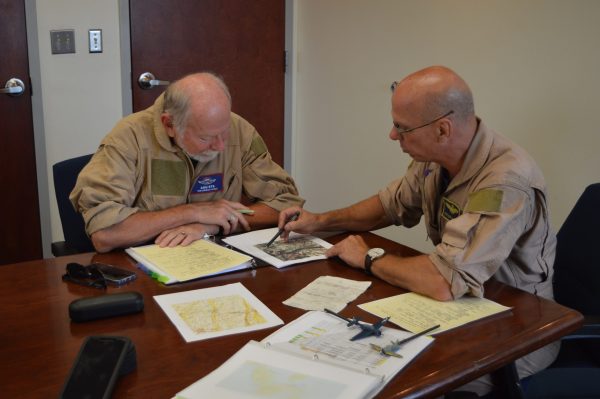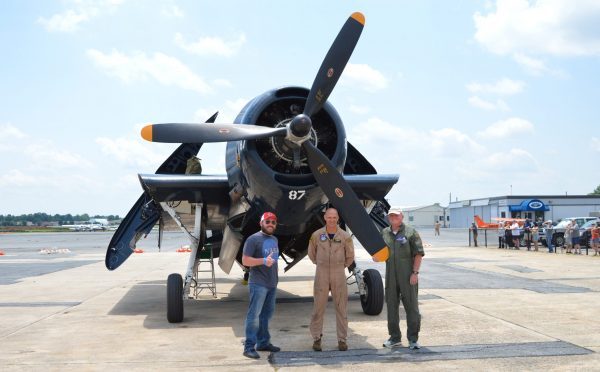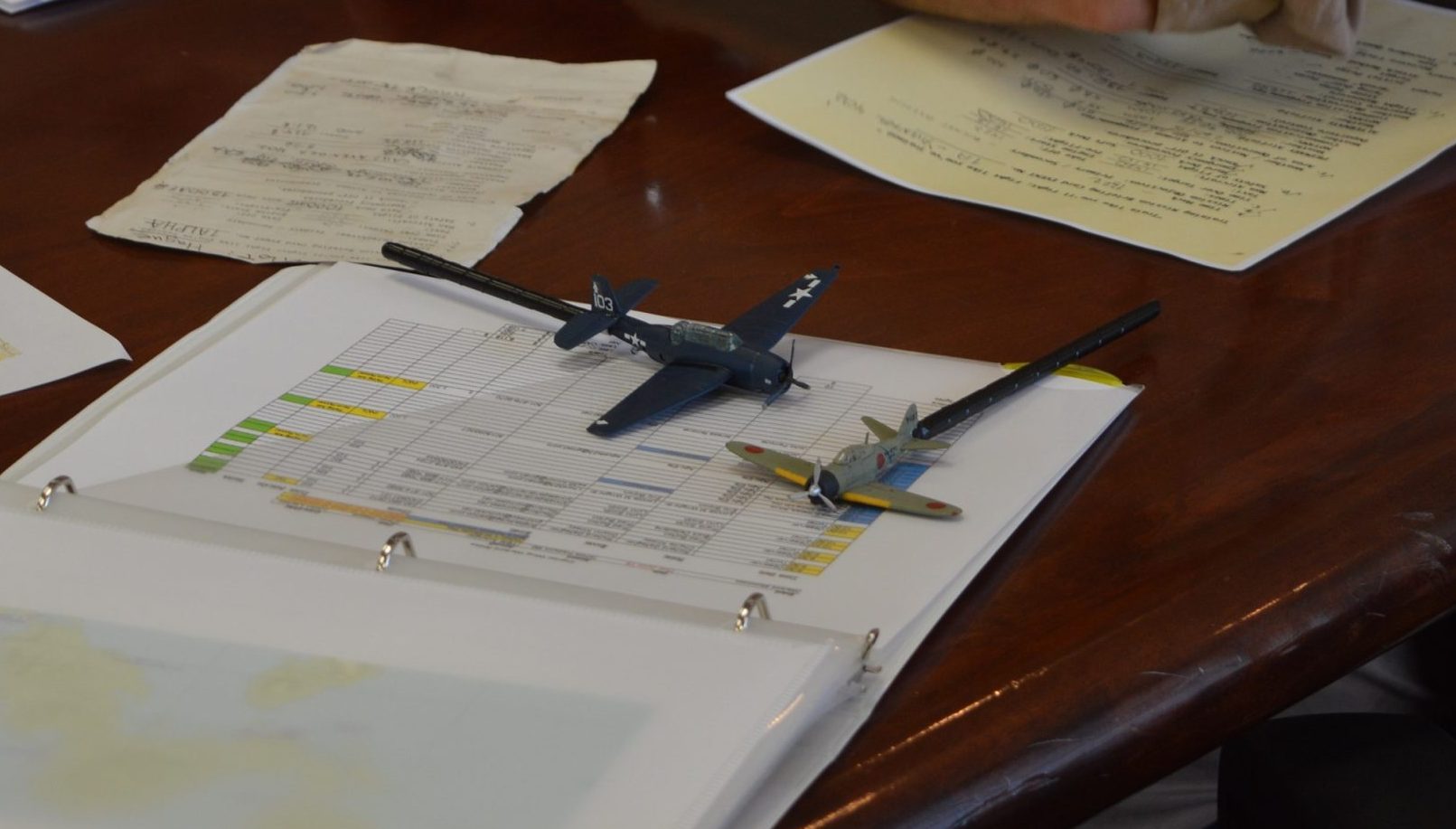Avenger Torpedo Mission Leaves Brunswick Bridge Intact
Pilot Peter Hague used model planes to demonstrate evasive maneuvers for each torpedo mission at the 2021 Commemorative Air Force Warbirds Showcase in Frederick, MD. (credit Anthony C. Hayes)
FREDERICK, MD — It may come as a surprise to modern-day visitors of bucolic Brunswick, Maryland that in the 1940s the town of was a busy hub for the B&O Railroad. With a six-mile-long rail yard along the Potomac, and several important bridges in the vicinity, Brunswick not only bustled with wartime activity, it could have been a strategic target for both the Germans and Japanese.
Thankfully, no enemy attacks against Brunswick ever occurred. But for two days last weekend, the town of Brunswick was repeatedly buzzed by a vintage TBM Avenger as the plane carried out a series of mock torpedo missions against the rail yard and the Petersville bridge.
The daring exercises (a premium package) were part of the Father’s Day Warbirds Showcase held here in Frederick by the Capital Wing of the Commemorative Air Force (CAF). The two-day event drew aviation fans from as far away as central Pennsylvania and New Jersey for up-close peeks and rides on one of three iconic planes of World War II: the TBM ‘Avenger’ “Doris Mae,” the L-5 ‘Sentinel’ “Gayle Ann,” or an open-cockpit Coast Guard N2S-4 ‘Stearman’.
The pleasure rides most patrons purchased came with short history lessons proffered by the knowledgeable pilots. But those concise introductions paled in comparison to the intense in-class and tarmac briefings that were required for the earnest crew members of each Avenger torpedo mission.
We sat in on two in-class briefings, and then followed a third crew for an up-close look at the storied warbird.
Peter Hague – whose 9-5 job these days is as a Captain with Jet Blue – was at the helm of the CAF’s TBM Avenger for all of the torpedo mission flights. Hague told us he has been a pilot since turning 16 – or thereabouts. “I would have soloed on my birthday, but my sister had the nerve to get married that day.”
Once inside a conference room for the mission briefing, Peter Hague was all business.

“I will not do anything outside of Federal Aviation Regulations,” explained Hague. “All safety procedures will be followed with this brief; there are no simulated emergency procedures. Everything will be an actual emergency if we have one. I’m going to treat you like you’re brand new crewman. I’m giving you some responsibilities to do. Things like following the briefing sheet you have in your hands. Follow through on that. You’re not just out for the ride, but you get the ticket punched with this one.”
Hague gave each of the five torpedo mission crews he took up the same sort of military style briefings he got when he was in the Navy. He said the primary objective (the Brunswick bridge) would actually build on the former objective, which was to get each crew to feel some of the experiences combat airmen would have had during WWII.
“This airplane (the TBM Avenger) is extremely hot. It is very noisy. It vibrates a lot. So you’re going to be very uncomfortable. And we’re going to be doing a lot of maneuvering. Our primary mission today is to attack a bridge. Your job is to navigate me to the breach.”
Navigation to the bridge was aided by the use of photographs and an aerial map. And while the objective was relatively close – approximately 16 miles away from the Fredrick airport – Hague discussed the maneuvers the Avenger would have to take should they encounter any enemy aircraft.
Admittedly, terms like “high yo-yo” “rolling pitch” “radius of turn” “pitch of nose” and “brake maneuver” sounded foreign at first. But with the possibility of finding a Japanese Zero your tail, Hague’s enlightening maneuvers lesson took on an urgent life of its own.
After a final in-class drill on emergency procedures, each crew met Hague at the Avenger for a walk-around inspection just ahead of their flights.
Pointing, prodding, rubbing and pulling at the plane as he went along, Hague said, “You want to look at the oil cooler to be sure there are no debris to clog the airway. Check for hot spots on each part of the engine and look over the general condition of the propeller and the structure of the aircraft. You want to make sure there are no dings or dents on anything. There shouldn’t be any flat spots on the tires. When I tap on the exhaust manifold, I’m looking and listening for cracks. A crack means hot air is escaping from somewhere in the engine compartment.”
Then there was the hydraulic system and the bomb bay doors and the… well, you get the picture. Hague’s walk-around was crisp but comprehensive, and we came away feeling like we really understood the workings of the TBM Avenger.

(credit Anthony C. Hayes/BPE)
Hague’s Sunday afternoon tarmac tutorial and pre-flight safety inspection actually turned up an issue with the old warbird – a softball-sized inspection plate was found missing from one of the rear elevators. This grounded the plane for about 40 minutes — until a replacement inspection plate could be procured from the airport mechanic’s shop. Once the new part was installed, all systems were go for another torpedo mission.
Objective: Brunswick
Were the torpedo missions a success?
Mid-Sunday “Navigator/Bombardier” Thomas Dembeck said the incredible maneuvers were a pleasant surprise, and he considered his mission, “A great opportunity… it was well worth the time and the experience.”
“Turret Gunner” Terre Rhoderick and “Navigator/Bombardier” Agu Ets were equally enthusiastic about their Saturday afternoon mission.
“I enjoyed it thoroughly,” said Ets. “It was very well done, through the whole scenario. It was as the pilot said: they wanted to give us a good feeling and understanding of what it would be like fighting in a World War Two plane with all of the action, the brake maneuvers, and so forth. After each maneuver, the pilot asked us how we were doing? We both kept saying, ‘Give us more,’ so we got more.”
Rhoderick said at no point did either he or Ets feel the need to ask Hague to take things easy.
“He did bank right, bank left, some nose up tight turns, then we dropped down for the run or the bridge. I kept thinking, ‘Come on – give us more G’s!’”
Ets added, “One interesting thing was the fact that I live in Brunswick and we ‘bombed’ the Petersville Road Bridge! I was familiar with all of the territory.”
Did Ets have a chance to even some scores with any bothersome neighbors?
“I’m not sure,” Ets laughingly replied, “unless they were on the bridge. But we located all the major things from our briefing: the rail yard; the initial point by Point of Rocks where the sharp end in the Potomac was headed toward the bridge. Before the bridge we had a breakout maneuver. Very nice.”
Rhoderick said he was just thrilled to see the war looking backward from the turret seat of the Avenger. “Hey, no Zero’s got us!”
Would he do it again, we asked in closing.
“In a heartbeat” exclaimed Rhoderick.

© Copyright 2021 Baltimore Post-Examiner. All Rights Reserved
Five WWII warbirds flying rides will be offered at Culpeper VA Saturday & Sunday July 3 & 4. The planes include the TBM Avenger, T-6/SNJ, Stinson L-5, PT-17 Stearman, PT-19 Cornell. The T-6/SNJ is a “Gold Race” winner at the Reno National Air Races. Five other vintage aircraft will be on static display. A flyover by 3 Stearman bi-planes will take place in the Noon hour on Sunday July 4. For more information or to schedule a ride, visit the Capital Wing of the Commemorative Air Force.

Anthony C. Hayes is an actor, author, raconteur, rapscallion and bon vivant. A one-time newsboy for the Evening Sun and professional presence at the Washington Herald, Tony’s poetry, photography, humor, and prose have also been featured in Smile, Hon, You’re in Baltimore!, Destination Maryland, Magic Octopus Magazine, Los Angeles Post-Examiner, Voice of Baltimore, SmartCEO, Alvarez Fiction, and Tales of Blood and Roses. If you notice that his work has been purloined, please let him know. As the Good Book says, “Thou shalt not steal.”

